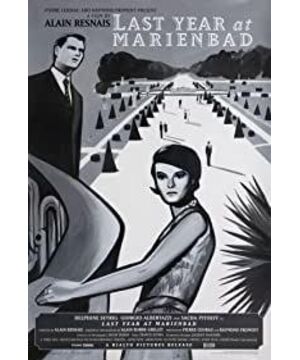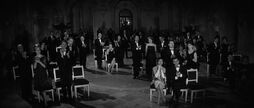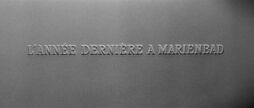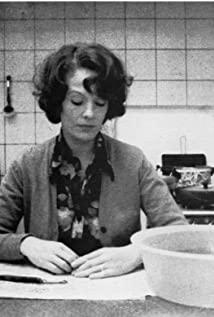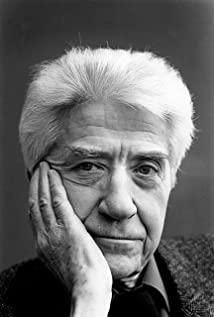The first time I saw this movie was really confusing. I don’t know where the story started to break, and then the audience had to be at the mercy of director Alain Resnais, watching the film in confusion, suspicion and anxiety.
This film basically takes the form of dialogue between the male and female protagonists (more about X persuading A), and revolves around whether the two met in Marienbad last year. It can be said that there is no story at all. After all, this work is a It's made up of tons of dialogue, flashbacks, a dissonant soundtrack, and more, stacked in chaotic order.
Even if the central topic of the film has been clearly thrown to the audience-whether the two met in Marienbad last year, the male and female protagonists in the film seem to be unable to reach an agreement anyway, and the male protagonist X tries to persuade the female protagonist A to believe this. meeting, and A has always denied and said that he does not know X at all.
Interestingly, in the creation of the script, the screenwriter and director of the film did not hold the same view on this issue. Screenwriter (and author of the original novel) Alain Robbe-Grillet made it clear that the meeting did not exist, nor did it exist last year or Marienbad (“there is no last year, and Marienbad is no longer on any map”); while the director Alain Resnais made the film with the idea that everything in the past had actually happened (“I could never have shot this film if I had not been convinced that their meeting had actually taken place”).
Even so, this contradiction has not prevented scholars and audiences from fully speculating, appreciating and interpreting the film. As director Resnais said, these derived audience interpretations are also part of the film. Therefore, the film itself has a quality of openness and uncertainty.
Before watching the film, as long as you understand a major premise, you can understand the first layer of the film. The premise is that the whole story is an intuitive display of the spiritual world, which means that the pictures we see and the words we hear are the visual expressions of a character's memory and spiritual level. As for the projection of which character's head this is from, we can slowly form our own guesses while watching the movie, but we can never get an exact verification. This is a manifestation of the uncertainty of the film.
Based on this premise, the film's non-linear narrative and inexplicable frame skipping have an explanation. When humans process memory in the brain, it is easy to miss certain details, or to emphasize a certain point repeatedly, or to consciously delete a certain part. We see shots and scenes from multiple angles of A standing in a room, but don't know what's going on in that room? We see that X repeatedly persuades A to believe the agreement of meeting and elopement a year ago, but does the other party's unusual evasive attitude and X's sudden loss in the monologue indicate that this is not just a simple love story?
Precisely because this is a spiritual world, all the unnatural places in the film just reveal that the projected subject's memory is being manipulated in this matter. We have seen part of the event, and there are also some omitted parts that need to be discovered to restore the truth of the truth.
This is the second level of the film. We can see from the first layer that this is a traumatized brain, maybe something happened in Marienbad last year that caused the male and female protagonists to process and react very differently in their recollection of the event. The second layer of the film is the truth of the event, but the film expresses it in a very metaphorical way, and it can even be said that it is difficult to verify this idea if you have not read the original book.
In Robbe-Grillet's script, there is a large section that clearly describes how X sexually assaults A, and this rape scene is not filmed in the film. We only see A standing alone in the room and hear X's repeated descriptions of various details of the room, and the truth in the room has not yet been reached.
The fact that A was subjected to sexual violence is replaced by a large number of overexposed scenes in the film. In a corridor, X took out a photo of A as irrefutable evidence of acquaintance last year. A seemed to have nowhere to escape and ran to the balcony. Due to the sudden exposure to the strong light outdoors, the whole picture is severely exposed, with A in a white dress leaning against the white wall, raising his hands to block the sunlight in vain.
This "absent" rape scene fits the essence of the film - a visual representation of consciousness, memory, and imagination. The original novel describes the rape plot in the third person, that is, the narrator is outside the story. But the voice in the film is always within the story (in the form of X's inner monologue or the dialogue between X and A). The trauma of being sexually assaulted may explain A's refusal to recall and vehement denial and forgetfulness of the (but still unsuccessful) encounter last year. At the same time, X refused to admit that he was the abuser, so in persuading the heroine, he whitewashed the whole incident as a love story that revolved around last year's agreement, and X himself was trapped in his own fantasy. Therefore, no matter which character's mental projection the picture is from, this "unseen" rape scene conforms to the perspective and position of the two protagonists.
Resnais' most unusual approach to the film is to tell two stories in one way, fulfilling his dual intention of "to be both concrete and abstract." The former is concretely embodied in the superficial love story on the first level, where X, as the main narrator of the story, constructs himself as an idiot who is waiting for the heroine. This is the positive side of the story, the authenticity of which is easily questioned by the fact that X, an unreliable narrator, contains numerous logical errors and contradictory views.
The latter abstract is embodied in the film form, the second layer of the film, the way in which the opposite of the story is presented—the entire film is a visualized spiritual world in which events are subjectively Construction or recombination with conspicuous gaps, omissions and repetitions. This is exactly the visual imitation of the human brain's processing of traumatic memories, which can be seen as a traumatic psychological projection of A, and can also be interpreted as a visual expression of X's sexual desires and fantasies.
The narration of the entire film is reversible and multi-directional, not one-way narration like the classic Hollywood movie mode. Any unnatural detail can turn the story from the front to the back, reminding the audience of the existence of the second layer of the film. significance.
View more about Last Year at Marienbad reviews


